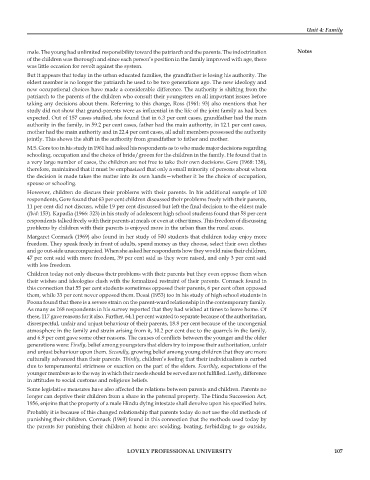Page 112 - DSOC201_SOCIAL_STRUCTURE_AND_SOCIAL_CHANGE_ENGLISH
P. 112
Unit 4: Family
male. The young had unlimited responsibility toward the patriarch and the parents. The indoctrination Notes
of the children was thorough and since each person’s position in the family improved with age, there
was little occasion for revolt against the system.
But it appears that today in the urban educated families, the grandfather is losing his authority. The
eldest member is no longer the patriarch he used to be two generations ago. The new ideology and
new occupational choices have made a considerable difference. The authority is shifting from the
patriarch to the parents of the children who consult their youngsters on all important issues before
taking any decisions about them. Referring to this change, Ross (1961: 93) also mentions that her
study did not show that grand-parents were as influential in the life of the joint family as had been
expected. Out of 157 cases studied, she found that in 6.3 per cent cases, grandfather had the main
authority in the family, in 59.2 per cent cases, father had the main authority, in 12.1 per cent cases,
mother had the main authority and in 22.4 per cent cases, all adult members possessed the authority
jointly. This shows the shift in the authority from grandfather to father and mother.
M.S. Gore too in his study in 1961 had asked his respondents as to who made major decisions regarding
schooling, occupation and the choice of bride/groom for the children in the family. He found that in
a very large number of cases, the children are not free to take their own decisions. Gore (1968: 138),
therefore, maintained that it must be emphasized that only a small minority of persons about whom
the decision is made takes the matter into its own hands—whether it be the choice of occupation,
spouse or schooling.
However, children do discuss their problems with their parents. In his additional sample of 100
respondents, Gore found that 63 per cent children discussed their problems freely with their parents,
11 per cent did not discuss, while 19 per cent discussed but left the final decision to the eldest male
(Ibid: 153). Kapadia (1966: 323) in his study of adolescent high school students found that 58 per cent
respondents talked freely with their parents at meals or even at other times. This freedom of discussing
problems by children with their parents is enjoyed more in the urban than the rural areas.
Margaret Cormack (1969) also found in her study of 500 students that children today enjoy more
freedom. They speak freely in front of adults, spend money as they choose, select their own clothes
and go out-side unaccompanied. When she asked her respondents how they would raise their children,
47 per cent said with more freedom, 39 per cent said as they were raised, and only 3 per cent said
with less freedom.
Children today not only discuss their problems with their parents but they even oppose them when
their wishes and ideologies clash with the formalized restraint of their parents. Cormack found in
this connection that 55 per cent students sometimes opposed their parents, 6 per cent often opposed
them, while 33 per cent never opposed them. Desai (1953) too in his study of high school students in
Poona found that there is a severe strain on the parent-ward relationship in the contemporary family.
As many as 168 respondents in his survey reported that they had wished at times to leave home. Of
these, 117 gave reasons for it also. Further, 64.1 per cent wanted to separate because of the authoritarian,
disrespectful, unfair and unjust behaviour of their parents, 18.8 per cent because of the uncongenial
atmosphere in the family and strain arising from it, 10.2 per cent due to the quarrels in the family,
and 6.9 per cent gave some other reasons. The causes of conflicts between the younger and the older
generations were: Firstly, belief among youngsters that elders try to impose their authoritation, unfair
and unjust behaviour upon them. Secondly, growing belief among young children that they are more
culturally advanced than their parents. Thirdly, children’s feeling that their individualism is curbed
due to temperamental strictness or exaction on the part of the elders. Fourthly, expectations of the
younger members as to the way in which their needs should be served are not fulfilled. Lastly, difference
in attitudes to social customs and religious beliefs.
Some legislative measures have also affected the relations between parents and children. Parents no
longer can deprive their children from a share in the paternal property. The Hindu Succession Act,
1956, enjoins that the property of a male Hindu dying intestate shall devolve upon his specified heirs.
Probably it is because of this changed relationship that parents today do not use the old methods of
punishing their children. Cormack (1969) found in this connection that the methods used today by
the parents for punishing their children at home are: scolding, beating, forbidding to go outside,
LOVELY PROFESSIONAL UNIVERSITY 107

